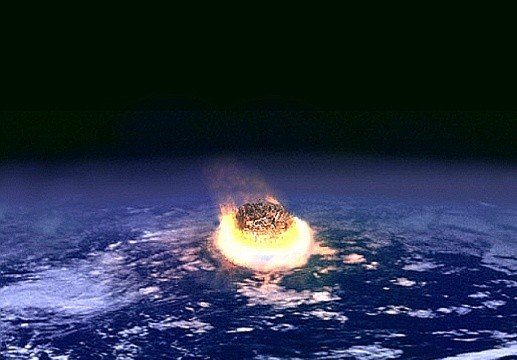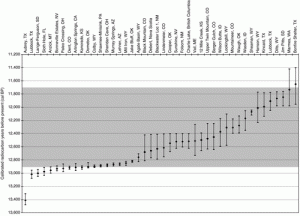
![]()
In a paper published in PNAS in 2007 ((Firestone RB, et al. (2007) Evidence for an extraterrestrial impact 12,900 years ago that contributed to the megafaunal extinctions and the Younger Dryas cooling. Proc Natl Acad Sci USA 104:16016–16021)), Firestone and others suggested that there was evidence that shows that the Younger Dryas period in the Northern Hemisphere was interrupted by a barrage of extraterrestrial comets at about 12.9 ka. This impact, the authors said, was the cause of abrupt climate change, a sudden cooling, that led to “broad-scale extinctions, and rapid human behavioral shifts at the end of the Clovis Period.”
In short, along with megafaunal extinctions (i.e. mammoths), the Clovis period of human development in North America was brought to a close by this barrage of comets. The evidence Firestone et al cited included magnetic grains with iridium, magnetic microspherules, carbon spherules, fullerenes with extraterrestrial helium, and nanodiamonds. From that and other physical evidence, Firestone et al proposed:
that one or more large, low-density ET objects exploded over northern North America, partially destabilizing the Laurentide Ice Sheet and triggering YD cooling. The shock wave, thermal pulse, and event-related environmental effects (e.g., extensive biomass burning and food limitations) contributed to end-Pleistocene megafaunal extinctions and adaptive shifts among PaleoAmericans in North America.
Their hypothesis was met with a fair amount of debate and discussion, particularly evident on several well-known science blogs (( The Younger Dryas comet-impact hypothesis: gem of an idea or fool’s gold [RealClimate]?, More Clovis Comet Debate and a Response from Dr.Richard Firestone [Anthropology.net], The Fantastic Mystery of the Younger Dryas [Greg Laden’s Blog])).
Now, Vance T. Holliday and David J. Meltzer, may have finally closed the debate with regard to the fate of the Clovis culture in a paper available free at Current Anthropology: The 12.9-ka ET Impact Hypothesis and North American Paleoindians. In this paper, Holliday and Meltzer challenge the ET impact hypothesis as a cause for Clovis collapse. Indeed, they challenge the automatic assumption that absence of post-Clovis occupation of Clovis sites should be interpreted as collapse at all.
… an examination of archaeological, geochronological, and stratigraphic evidence fails to provide evidence of a demographic collapse of post-Clovis human populations, especially where the Clovis and post-Clovis site records are reasonably well constrained chronologically. Although few Clovis sites contain evidence of an immediate post-Clovis occupation, interpreting that absence as population collapse is problematic because the great majority of Paleoindian sites also lack immediately succeeding occupations.
The authors stress that, when it comes to Paleoindian sites, single occupation is the norm. It isn’t unusual for either a Clovis or a post-Clovis site to show evidence for only a single occupation. Archaeological sites generally follow the rules of superposition, with oldest materials at lower strata and younger material at higher strata. Sites like tells in the Near East or Mesopotamia often have multiple levels of culture that demonstrates successive occupations through time at the same site as newer cultures build on the ruins of older ones. Not so, however, with most, Paleoindian sites. This is because “Paleoindian groups had a relatively empty landscape and unfettered mobility, and they rarely used the same spot twice, save in the case of fixed places on the landscape that provided important but rare resources, such as outcrops of high-quality stone for tool making or freshwater springs ((V.T. Holliday and D.J. Meltzer (2010). The 12.9-ka ET Impact Hypothesis and Norht American Paleoindians. Current Anthropology, 51(5), 575-607, DOI: 10.1086/656015.)).”
The absence of successive Paleoindian occupation of sites is an important point because the ET Impact Hypothesis, in part, relies on this as evidence for societal collapse of the Clovis culture. Holliday and Meltzer, however, make a very convincing case that, while immediate post-Clovis occupation of sites is rare, there is a “trend of continuous occupation” during the period in which the barrage of comets -the ET impact event- is hypothesized to have occurred.

Holliday and Meltzer aren’t attempting to refute the hypothesis that some sort of extraterrestrial impact occurred at around 12.9 ka. They are, however, eliminating the alleged disappearance of Clovis culture at several sites as evidence for societal collapse due to their inability to cope with sudden changes in subsistence as a result of the sudden absence of megafauna. In addition to showing the faulty assumptions related to the absence of successive occupation at Paleoindian sites, Holliday and Meltzer also question the methods of choosing sites that some proponents of the ET impact hypothesis have used which may have introduced bias in their results. Also questioned is the fact that bison populations appear relatively unaffected by the alleged ET event, which suggests not an ET impact but, rather, a competitive release as large grazers go extinct for other reasons.
 While Holliday and Meltzer weren’t necessarily refuting the ET impact hypothesis itself, others might be. Another bit of evidence the ET Impact proponents cite is the presence of nanodiamonds at the YD boundary. This claim has recently been challenged by Daulton, Pinter and Scott (Aug. 2010). They found that there was no evidence of nanodiamonds as claimed by several papers since 2007, among which is included the Firestone et al report. Instead, what they discovered were graphene and graphane-oxide aggregates that weren’t constrained to just the YD boundary ((T.L. Daulton, N. Pinter, and A.C. Scott (2010). No evidence of nanodiamonds in Younger-Dryas sediments to support an impact event. PNAS, 107(37), 16043-16047; published ahead of print Aug. 30, 2010, DOI: 10.1073/pnas.1003904107)).
While Holliday and Meltzer weren’t necessarily refuting the ET impact hypothesis itself, others might be. Another bit of evidence the ET Impact proponents cite is the presence of nanodiamonds at the YD boundary. This claim has recently been challenged by Daulton, Pinter and Scott (Aug. 2010). They found that there was no evidence of nanodiamonds as claimed by several papers since 2007, among which is included the Firestone et al report. Instead, what they discovered were graphene and graphane-oxide aggregates that weren’t constrained to just the YD boundary ((T.L. Daulton, N. Pinter, and A.C. Scott (2010). No evidence of nanodiamonds in Younger-Dryas sediments to support an impact event. PNAS, 107(37), 16043-16047; published ahead of print Aug. 30, 2010, DOI: 10.1073/pnas.1003904107)).
It probably wasn’t a meteor or comet that caused the disappearance of the Clovis point. Rather, it was probably just a cultural decision. Perhaps the Clovis point was the platform shoe or the bell-bottom pants of North American antiquity.
Related articles by Zemanta
- No evidence for Clovis comet catastrophe, archaeologists say (eurekalert.org)
- Impact hypothesis loses its sparkle (eurekalert.org)
- No evidence for Clovis comet catastrophe, archaeologists say (spacefellowship.com)
- Scientist Smackdown: No Proof That a Comet Killed the Mammoths? | 80beats (blogs.discovermagazine.com)
- Scientists discover nanodiamonds in Greenland ice (physorg.com)
- Comet theory carbonized (nature.com)
Holliday, V., & Meltzer, D. (2010). The 12.9-ka ET Impact Hypothesis and North American Paleoindians Current Anthropology, 51 (5), 575-607 DOI: 10.1086/656015

Leave a Reply
You must be logged in to post a comment.